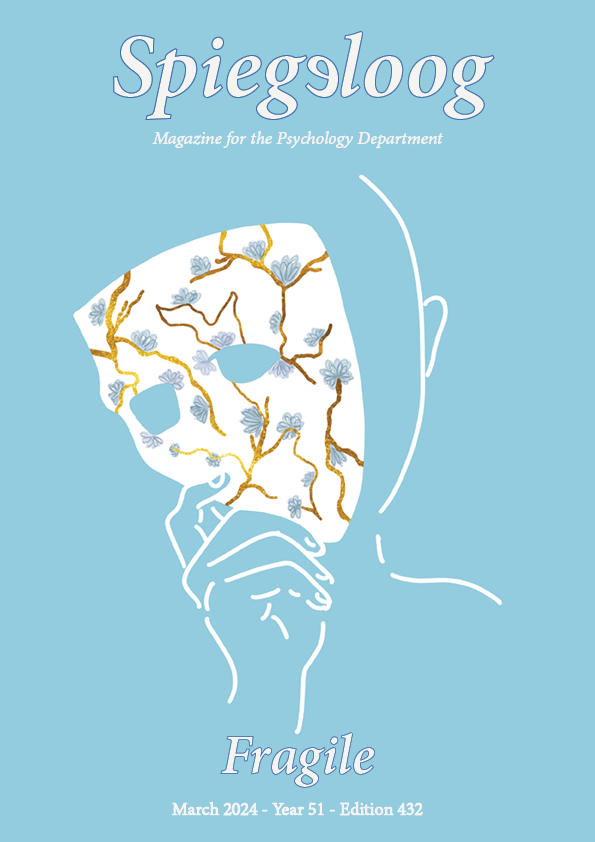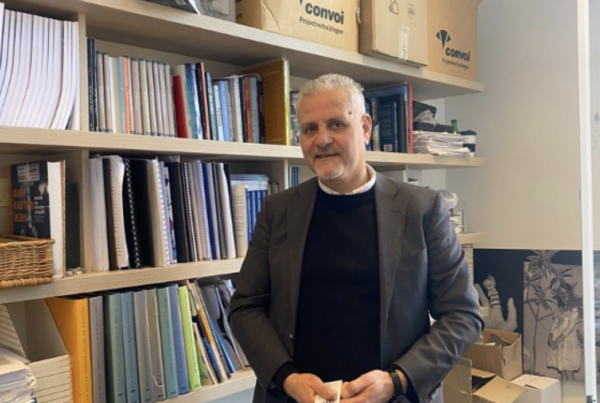
Dear readers,
Spring is just around the corner, and with it new beginnings. While often uplifting, it can also be a tumultuous period for many as we shake off the winter blues and prepare ourselves for upcoming changes. Now, when we hear the word fragile, our minds naturally gravitate towards emotional fragility. Maybe we even conjure up an image of someone with glistening eyes, who is perceived as overly emotional. But fragility is not limited to our (current) emotions. It can be understood as anything that is volatile or unstable by nature, just like springtime. With this in mind, we welcome our next issue – Spiegeloog 432: Fragile.

Cover by Anushka Sabhanam
Viktor begins our issue using personal stories to tenderly demonstrate how different types of memory play a role in shaping our identity. How effective are trigger warnings? Anika considers both sides of a controversial issue – from protecting individuals from distress to fostering resilience through exposure to adversity. Our guest writers from SIOS discuss the credibility crisis in psychology by looking at recent studies. Do these studies point to progress, or do our research practices still need work? The age-old wisdom that doctors are akin to Gods has taken on a contemporary twist, as the conviction that enchanting medical technologies can usurp death. Shriya illuminates the truths and whys behind futile end of life care. Then, read Aline’s personal musings on how one’s perception of beauty evolves over time, from a relentless pursuit to a path of self-acceptance. Following this, Magda looks at why parental involvement outperforms parental pressure when it comes to their children’s academic success and, more importantly, their wellbeing. From challenges to opportunities – Paula explores the intricacies of moving, its effects on development, and the role of resilience in well-being. Aki’s piece takes a deep dive into the role of the femme fatale and the less-known archetype, femme fragile, in literature and media, examining their influence on gender stereotypes. In her essay, Anushka discusses the challenges and benefits of accommodating individual differences in intellectual disabilities and giftedness, in inclusive classrooms.
For our columns, Denny Borsboom invites us on a philosophical exploration of fragility, from vases to psychological dispositions. Then, Laura has an interesting conversation with Professor Ihab Saloul for International Classroom, discussing his newly proposed humanitarian fund to support students and academics affected by the disaster in Gaza. To close, Evita ponders the uncertainty of defining moments in life.
Enjoy the new issue!
Anushka & Evita
Dear readers,
Spring is just around the corner, and with it new beginnings. While often uplifting, it can also be a tumultuous period for many as we shake off the winter blues and prepare ourselves for upcoming changes. Now, when we hear the word fragile, our minds naturally gravitate towards emotional fragility. Maybe we even conjure up an image of someone with glistening eyes, who is perceived as overly emotional. But fragility is not limited to our (current) emotions. It can be understood as anything that is volatile or unstable by nature, just like springtime. With this in mind, we welcome our next issue – Spiegeloog 432: Fragile.

Cover by Anushka Sabhanam
Viktor begins our issue using personal stories to tenderly demonstrate how different types of memory play a role in shaping our identity. In her essay, Anushka discusses the challenges and benefits of accommodating individual differences in intellectual disabilities and giftedness, in inclusive classrooms. How effective are trigger warnings? Anika considers both sides of a controversial issue – from protecting individuals from distress to fostering resilience through exposure to adversity. Our guest writers from SIOS discuss the credibility crisis in psychology by looking at recent studies. Do these studies point to progress, or do our research practices still need work? The age-old wisdom that doctors are akin to Gods has taken on a contemporary twist, as the conviction that enchanting medical technologies can usurp death. Shriya illuminates the truths and whys behind futile end of life care. Then, read Aline’s personal musings on how one’s perception of beauty evolves over time, from a relentless pursuit to a path of self-acceptance. Following this, Magda looks at why parental involvement outperforms parental pressure when it comes to their children’s academic success and, more importantly, their wellbeing. From challenges to opportunities – Paula explores the intricacies of moving, its effects on development, and the role of resilience in well-being. Aki’s piece concludes, where she takes a deep dive into the role of the femme fatale and the less-known archetype, femme fragile, in literature and media, examining their influence on gender stereotypes.
For our columns, Anushka reviews ‘The In-Between’, on moments between life and death, for Tabula Rasa. Anushka and Evita pay a visit to Stedelijk Museum, currently showcasing live art performances in the style of Marina Abramovic. To close, Evita ponders the uncertainty of defining moments in life.
Enjoy the new issue!
Anushka & Evita



